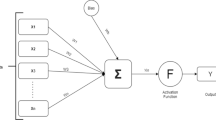Abstract
Social media data analysis has emerged as an important part of the new generation of information technology. However, Social media data analysis is based on Data Mining. A new algorithm based on \(\hbox {M}^{\mathrm{x}}/\hbox {G}/1\) Queue model is proposed to calculate money flow of Social media stocks. The proposed algorithm exploits the transaction data behind the social media stocks, such as volume, the Commission transaction queue, closing price, etc. Through the Social media stock trading data, we use Matlab programming to carry out data mining and calculation of money flows, and draw the money inflow and outflow curve. The experimental results show that our new model has strong practicability for the data mining of Social media stocks. The experimental results can also reflect the development of the social media more clearly. The method of data mining on the Social media stocks provides an indirect way to study the economic and regional economy of the Social media stocks.







Similar content being viewed by others
References
Yao, H., Xiong, M., et al.: Mining multiple spatial–temporal paths from social media data. Future Gener. Comput. Syst. https://doi.org/10.1016/j.future.2017.08.003 (2017)
Liu, S., Young, S.D.: A survey of social media data analysis for physical activity surveillance. J. Forensic Legal Med. https://doi.org/10.1016/j.jflm.2016.10.019 (2017)
Blazquez, D., Domenech, J.: Big Data sources and methods for social and economic analyses. Technol. Forecast. Soc. Change. https://doi.org/10.1016/j.techfore.2017.07.027 (2017)
Injadat, M.N., Salo, F., Nassif, A.B.: Data mining techniques in social media: a survey. Neurocomputing 214, 654–670 (2016)
Shao, H., Zhang, Y., Li, W.: Extraction and analysis of city’s tourism districts based on social media data. Comput. Environ. Urban Syst. 65(9), 66–78 (2017)
Brandt, T., Bendler, J., Neumann, D.: Social media analytics and value creation in urban smart tourism ecosystems. Inf. Manag. 54, 703–713 (2017)
Cui, W., Wang, P.: An algorithm for event detection based on social media data. Neurocomputing 254, 53–58 (2017)
Singh, A., Shukl, N., et al.: Social media data analytics to improve supply chain management in food industries. Transp. Res. E. (2017)
Qiang, W., Zhi, J., Yan, X.: Service discovery for internet of things based on probabilistic topic model. J. Softw. 25(8), 1640–1658 (2014)
Zhihong, Q., Yiju, W.: loT Technology and Application. ACTA Electron. Sin. 40(5), 1023–1029 (2012)
Yunquan, G., Xiaoyong, L., Binxing, F.: Survey on the search of internet of things. J. Commun. 36(12), 57–76 (2015)
Haiming, C., Li, C., Kaibin, X.: A comparative study on architectures and implementation methodologies of internet of things. Chin. J. Comput. 36(1), 168–188 (2013)
Haiming, C., Li, C., Kaibin, X.: Information sensing and interaction technology in internet of things. Chin. J. Comput. 35(6), 1147–1163 (2012)
Qinyan, M., Shubin, S.: Information model and capability analysis of internet of things. J. Softw. 25(8), 1685–1695 (2014)
l-Fuqaha, A., Guizani, M., et al.: Internet of things: a survey on enabling technologies, protocols and applications. IEEE Commun. Surv. Tutor. https://doi.org/10.1109/COMST.2015.2444095 (2015)
Nan, J., Liang, Y., et al.: A novel exercise thermophysiology comfort prediction model with fuzzy logic. Mobile Inf. Syst. https://doi.org/10.1155/2016/8586493 (2016)
Qingzhen, X., Susu, B., et al.: \(\text{ M }^{\text{ x }}/\text{ G }/1\) queue with multiple vacations. Stoch. Anal. Appl. 25(1), 127–140 (2007)
Bo, C., Wen-Sheng, C.: Noisy image segmentation based on wavelet transform and active contour model. Appl. Anal. 90(8), 1243–1255 (2011)
Bo, C., Qing-Hua, Z., et al.: A novel adaptive partial differential equation model for image segmentation. Appl. Anal. 93(11), 2440–2450 (2012)
Xiuli, L., Zengqin, Z.: Iterative technique for a third-order differential equation with three-point nonlinear boundary value conditions. Electron. J. Qual. Theory Differ. Equ. 12(1), 1–10 (2016). https://doi.org/10.14232/ejqtde.2016.1.12
Xiuli, L., Zengqin, Z.: Sign-changing solution for a third-order boundary-value problem in ordered Banach space with lattice structure. Bound. Value Probl. https://doi.org/10.1186/1687-2770-2014-132 (2014)
Qingzhen, X., Zhoutao, W., et al.: Thermal comfort research on human CT data modeling. Multimed. Tools Appl. https://doi.org/10.1007/s11042-017-4537-9 (2017)
Xiuli, L., Zengqin, Z.: Existence and uniqueness of symmetric positive solutions of 2n-order nonlinear singular boundary value problems. Appl. Math. Lett. 26, 92–698 (2013)
Peihe, W., Lingling, Z.: Some geometrical properties of convex level sets of minimal graph on 2-dimensional Riemannian manifolds. Nonlinear Anal. Theory Method Appl. 130(1), 1–13 (2016)
Peihe, W., Dekai, Z.: Convexity of level sets of minimal graph on space form with nonnegative curvature. J. Differ. Equ. 262, 5534–5564 (2017)
Fushan, L., Qingyong, G.: Blow-up of solution for a nonlinear Petrovsky type equation with memory. Appl. Math. Comput. 274, 383–392 (2016)
Li, G., Zhang, Z., Wang, L., Pan, J., Chen, Q.: One-class collaborative filtering based on rating prediction and ranking prediction. Knowl. Based Syst. 124, 46–54 (2017)
Li, G., Weihua, O.: Pairwise probabilistic matrix factorization for implicit feedback collaborative filtering. Neurocomputing 204, 17–25 (2016)
Li, G., Wang, L., Li, Y.: Robust personalized ranking from implicit feedback. Int. J. Pattern Recognit. Artif. Intell. 30(1), 1659001:1-28 (2016)
Li, G., Chen, Q.: Exploiting explicit and implicit feedback for personalized ranking. Math. Probl. Eng. 2016, 1–11 (2016)
Yang, J., Li, J., Liu, S.: A novel technique applied to the economic investigation of recommender system. Multimed. Tools Appl. 8, 1–16 (2017)
Xu, Q., Wu, J., Chen, Q.: A novel mobile personalized recommended method based on money flow model for stock exchange. Math. Probl. Eng. 2014, 353910 (2014)
Xu, Q.: A novel machine learning strategy based on two-dimensional numerical models in financial engineering. Math. Probl. Eng. 2, 1–6 (2013)
Ma, Z.: Te Geom/G/1 queue with multiple vacation and server set-up/close times. Oper. Res. Manag. Sci. 13(1), 21–25 (2004)
Acknowledgements
The Project was supported by the National Natural Science Foundation of China (No. 61402185), Natural Science Foundation of Guangdong Province (No. 2015A030313382), and Guangdong Provincial Public Research and Capacity Building Foundation funded project (Nos. 2016A020223012, 2015A020217011).
Author information
Authors and Affiliations
Corresponding author
Rights and permissions
About this article
Cite this article
Xu, Q., Li, M. A new cluster computing technique for social media data analysis. Cluster Comput 22 (Suppl 2), 2731–2738 (2019). https://doi.org/10.1007/s10586-017-1436-9
Received:
Revised:
Accepted:
Published:
Issue Date:
DOI: https://doi.org/10.1007/s10586-017-1436-9




